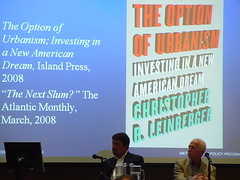The biggest reason for DC to focus on streetcars and light rail rather than bus rapid transit
I "wrote" the gist of this blog entry in my head on Saturday, after hearing a DDOT employee speak at the North Capitol "cloverleaf" Urban Design and "Transportation" Study (the transportation aspects shown at the meeting were pretty pathetic, I'd call it "and "traffic engineers" study isntead) about the various plans for enhanced bus service, called "bus rapid transit" throughout the city.
I said to myself, when we have limited funds and the constant need to strengthen DC's economic competitiveness, and when fixed rail transit seems to be the only kind of substantive transit investment in the U.S. that generates substantive spillover revitalization benefits (in some situations, streetscape investments, aligned with other transit investments can be net positive as well), then we shouldn't really be focusing on bus rapid transit as a priority, except in situations when fixed rail transit is out of the question.
But I didn't get around to writing it up.
The Overhead Wire, in "One Dozen Per Million" quotes Chris Leinberger, director of the real estate program at the U of Michigan School of Architecture, a fellow at Brookings Institution, and author of Option of Urbanism saying:
I have never seen a dollar of real estate investment generated by a bus stop.
That's it in a nutshell.
When you spend public dollars, especially in constrained times, you need to ensure that each dollar achieves the maximum return on investment. Center cities can't waste dollars. As I often say, it doesn't matter that DC kicks the butt of Baltimore or Pittsburgh or Philadelphia or Detroit, because we compete with Montgomery County, Arlington County, and Alexandria (not to mention Fairfax County for high-value headquarters businesses).
We can't waste money, and that means an expansive definition of waste that includes opportunity costs of investment not created. (That leads to another post soon, on the new DC Circulator routes.)
(Flickr image by jmv.)




0 Comments:
Post a Comment
<< Home